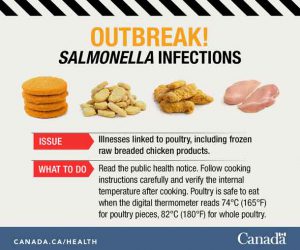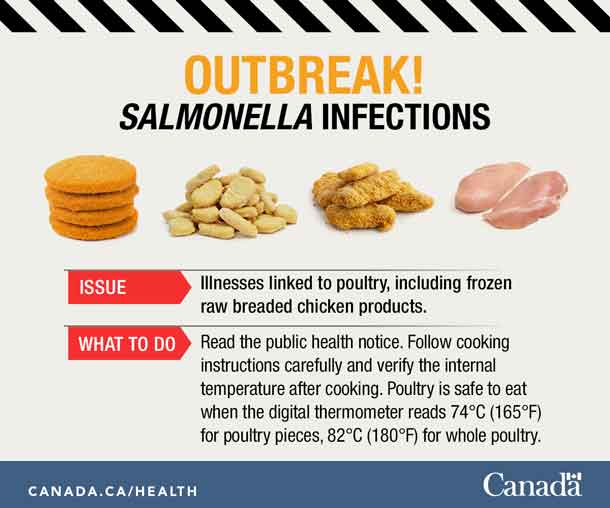 No Recall Warnings Issued – Health Canada Providing Updates
No Recall Warnings Issued – Health Canada Providing Updates
OTTAWA – In Alberta, Ontario, Quebec, and New Brunswick, there have been a total of 30 cases of Salmonella illness linked to poultry, including frozen raw breaded chicken products. There have been no recall warnings associated with this outbreak. The Public Health Agency of Canada is collaborating with provincial public health partners, the Canadian Food Inspection Agency and Health Canada to investigate an outbreak of Salmonella Enteritidis infections in four provinces with cases of human illness linked to poultry, including frozen raw breaded chicken products. The investigation is ongoing, and this public health notice will be updated on a regular basis as the investigation evolves.
The risk to Canadians is low. Salmonella is commonly found in raw chicken and frozen raw breaded chicken products. Illnesses can be avoided if safe food handling, preparation and cooking practices are followed when preparing these types of food products.
This outbreak is a reminder to properly handle, cook and store poultry, including frozen breaded chicken products to avoid getting sick. Frozen raw breaded chicken products contain raw poultry and should be handled and prepared no differently from other raw poultry products. Canadians are advised to follow cooking instructions carefully and verify the internal temperature after cooking before consuming these products. Frozen raw breaded chicken products and raw poultry pieces must be cooked to an internal temperature of at least 74°C (165°F) to ensure they are safe to eat. Whole poultry must be cooked to an internal temperature of at least 82°C (180°F).
Investigation Summary
Currently, there are 30 cases of Salmonella Enteritidis illness in four provinces: Alberta (2), Ontario (17), Quebec (7), and New Brunswick (4). Four individuals have been hospitalized. Individuals became sick between May 2017 and February 2018. The average age of cases is 32 years, with ages ranging from 1 to 73 years. The majority of cases (57%) are male.
Based on the investigation findings to date, exposure to poultry, including frozen raw breaded chicken products has been identified as a source of illness. Several individuals who became ill reported consuming a mix of poultry and frozen raw breaded chicken products. The Canadian Food Inspection Agency is conducting a food safety investigation into a source of the outbreak. At this time, there is no food recall warning associated with this outbreak. The outbreak investigation is ongoing.
Who is most at risk?
Anyone can become sick with a Salmonella infection, but infants, children, seniors and those with weakened immune systems are at higher risk of serious illness because their immune systems are more fragile.
Most people who become ill from a Salmonella infection will recover fully after a few days. It is possible for some people to be infected with the bacteria and not get sick or show any symptoms, but still be able to spread the infection to others.
What should you do to protect your health?
Frozen raw breaded chicken products may appear to be pre-cooked or browned but they contain raw chicken and should be handled and prepared no differently from other raw poultry products.
Foods carrying Salmonella may look, smell and taste normal, so it’s important to follow our safe food handling tips for buying, chilling, thawing, cleaning, cooking, and storing poultry products:
- Wash your hands thoroughly with soap and warm water before and after handling all types of raw poultry.
- Always follow package cooking instructions. Cook poultry to a safe internal temperature that has been checked using a digital thermometer. Raw poultry pieces should be cooked to an internal temperature of 74°C (165°F). Whole poultry should be cooked to an internal temperature of 82°C (180°F).
- Eggs and egg-based foods should be fully cooked to ensure they are safe to eat.
- Keep raw poultry away from other food while shopping, storing, repackaging, cooking and serving foods.
- Never rinse poultry before using it because the bacteria can spread everywhere the water splashes, creating more of a hazard.
- Use warm soapy water to clean knives, cutting boards, utensils, your hands and any surfaces that have come in contact with food, especially meat, poultry and fish.
- If you have been diagnosed with a Salmonella infection or any other gastrointestinal illness, do not cook food for other people.
- For more information read our poultry safety fact sheet.
If you are preparing frozen raw breaded chicken products, such as nuggets, strips or burgers, the following precautions should be taken to protect your health:
- Do not eat raw or undercooked frozen breaded chicken products. Cook all frozen breaded products to an internal temperature of at least 74°C (165°F) to ensure they are safe to eat.
- Microwave cooking of frozen raw breaded poultry products including chicken nuggets, strips or burgers is not recommended because of uneven heating.
- Always follow package cooking instructions, including products labelled Uncooked, Cook and Serve, Ready to Cook, or Oven Ready.
- Wash your hands thoroughly with soap and warm water before and after handling frozen raw breaded chicken products.
- Use a separate plate, cutting board and utensils when handling frozen raw breaded chicken products to prevent the spread of harmful bacteria.
- Do not re-use the same plate, cutting board or utensils on breaded chicken products after they have been cooked, unless the plate has been thoroughly washed.
- Use a digital food thermometer to verify that frozen raw breaded chicken products have reached at least 74°C (165°F). Insert the digital food thermometer through the side of the product, all the way to the middle. Oven-safe meat thermometers that are designed for testing whole poultry and roasts during cooking are not suitable for testing nuggets, strips or burgers.
What are the symptoms?
Symptoms of a Salmonella infection, called salmonellosis, typically start 6 to 72 hours after exposure to Salmonella bacteria from an infected animal or contaminated product.
Symptoms include:
- fever
- chills
- diarrhea
- abdominal cramps
- a headache
- nausea
- vomiting
These symptoms usually last for four to seven days. In healthy people, salmonellosis often clears up without treatment. In some cases, severe illness and hospitalization may occur. People who are infected with Salmonella bacteria can be infectious from several days to several weeks. People who experience symptoms, or who have underlying medical conditions, should contact their healthcare provider if they suspect they have a Salmonella infection.
What is the Government of Canada doing?
The Government of Canada is committed to food safety. The Public Health Agency of Canada leads the human health investigation of an outbreak and is in regular contact with its federal and provincial partners to monitor and take collaborative steps to address outbreaks.
Health Canada provides food-related health risk assessments to determine whether the presence of a certain substance or microorganism poses a health risk to consumers.
The Canadian Food Inspection Agency conducts food safety investigations into the possible food source of an outbreak.
The Government of Canada will continue to update Canadians as new information related to this investigation becomes available.

